-
February 26, 2020 by Total Fire and Safety

Restaurant fires destroy more than property. Restaurants hold priceless memories of celebrations and firsts, meetings with important people, backgrounds for special announcements or the reliable spot to pick up favorite weekday takeout meals. With a fire, they all go up in smoke—literally. Restaurant fires can be devastating, not only to the owners and patrons, but to the employees as well.
Nearly 8,000 restaurant fires occur each year resulting in $165 million in property damage. According to the NFPA, cooking equipment was the leading cause of restaurant fires (61%), electrical equipment (9%), heating equipment (9%), and smoking materials (7%). What’s the best way to protect your restaurant from a fire? Understand the dangers and prevention measures you can take to skirt disaster in your dining or takeout establishment.
DANGER:
Exhaust Systems and Ductwork
The vents and fans behind ovens and stoves accumulate a buildup of grease. Since the vents and fans extract flammable vapors, a spark can light grease buildup. Oven hoods above stoves, can also harbor flammable vapors from contaminated cooking air. This can feed through the exhaust system and cause a fire hazard. Also included in these systems are grease traps. Most commercial kitchens are required to maintain a grease trap preventing oils and fats from clogging sewers.
PREVENTION
- Clean all areas daily
- Twice a year, have a thorough hood cleaning by professionals
- Clean grease traps monthly, quarterly, or yearly as mandated by the NFPA
DANGER:
Gas Leaks
Gas leaks are the most catastrophic cause of restaurant fires because they cause an explosion. Gas leaks occur when faulty equipment is unable to support the flow of gas and leaks flammable gas in the air. A simple electrical device can ignite the gas and lead to an explosion.
PREVENTION
- Be alert and detect the signs of a gas leak (gas smell, orange/yellow flames, extinguished pilot lights)
- Perform equipment inspections daily and replacement of worn out equipment
DANGER:
Electrical Problems
Heat from unsafe or poor wiring in switches, sockets, or plugs can spark flammable or combustible materials. Overloading outlets, outdated wiring, and overpowering kitchen equipment can lead to a fire or even explosion.
PREVENTION
- Use only commercial equipment that is up-to-code
- Update wiring that can handle a busy kitchen
In the unfortunate event a restaurant fire occurs, a fire suppression system is your best protection. A restaurant fire suppression system is designed to provide fire protection for restaurant cooking appliances, exhaust hoods, and ducts. A fire suppression system detects fires through heat sensors, often before the kitchen staff does. When automatically discharged, the fire can be suppressed at its earliest stages. The result is minimal damage to the kitchen and minimal equipment down time.
Keep your restaurant kitchen safe from fires by properly installing and maintaining a working fire suppression system and empowering employees with fire safety and response training. It can mean the difference between a localized fire and a major blaze.
If you’re ready to safeguard your kitchen from a restaurant fire, Total Fire and Safety can test, service, and install fire suppression systems. TFS also provides first aid and fire extinguisher training on-site. Give us a call today and let our professionals provide “total” assurance your restaurant is protected from fire. Call us at 630.960.5060.
Category: Business Safety, Fire Equipment Inspections, Suppression system, Total Fire and Safety Tags: commercial fire protection, commercial fire safety, commercial fire suppression, fire and safety equipment, fire and safety needs, fire supression system, Total Fire & Safety | Comments Off on The Dangers and Prevention of Restaurant Fires
-
November 12, 2019 by Total Fire and Safety
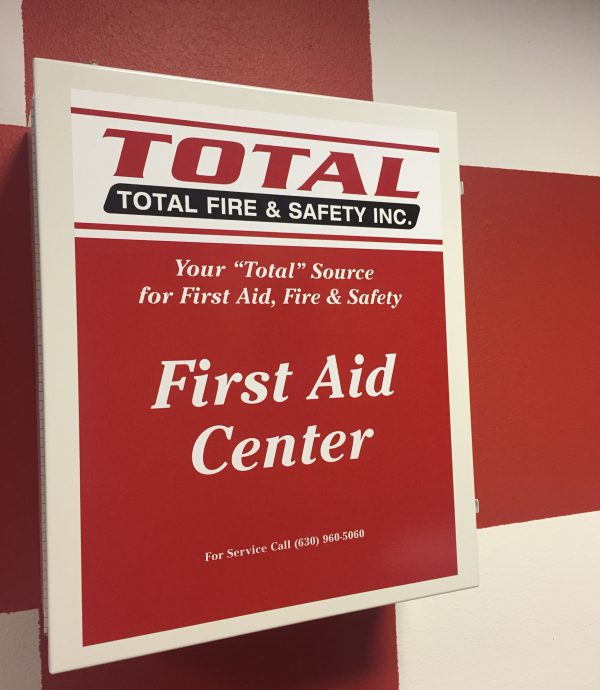
Does your organization have a first aid kit hanging on the wall? It sits there silently like a dutiful soldier, ready and waiting for any emergency. But with winter on its way, you may be surprised at how often that first aid kit can be called into service during the coldest months of the year.
Winter weather can easily compromise employee safety, whether the workplace is outdoors or in an office. It is important to keep first aid kits well stocked with winter safety essentials. Before you start planning your holiday office party, let’s look at your first aid kit and what we can do to “winterize” it.
OSHA has established a list of required first aid supplies for the workplace. Depending on the business and specifics of the environment, there are different first aid requirements. Employers are responsible for keeping the first aid kit stocked and up to date with the necessary supplies needed. They include:
- Band-aids, Elastic Bandages/Adhesive Tape, Sterile Gauze Pads/Rolls and Large Pressure Bandages in different shapes and sizes of bandages for possible falls, cuts, and scrapes. The opening of cracked, chapped winter skin can precipitate the need for a band-aid or a fall on the ice can merit more serious first aid treatment.
- Non-Latex Gloves, Antiseptic wipes, Peroxide and Alcohol and Triple Antibiotic Ointment will help keep those helping tend a wound safe, and also help the wound heal more quickly. Protect skin from contamination.
- Eye Pads and Eye Wash can help tend weather-related discomforts on the way into work.
- Tongue Depressors can be used to check throat irritations during winter flu season or be used as splints for possible weather-related injuries.
- CPR Shields can protect users from bodily fluids when CPR is essential. In winter, shoveling and overexertion in the cold can lead to cardiac arrest and the need for onsite CPR. Total Fire & Safety can help with employee training in this area.
- Triangular Bandages can be onsite in the event of the need for a sling or tourniquet. Falls on ice or minor accidents may require such dressings.
- Cold Packs: Instant cold packs help with sprains, fractures, burns, etc.… common injuries associated with falls, accidents, or overheating.
- Thermometer: Determines body temperatures. The flu and other winter maladies can be contagious! Detecting an above normal temperature in an employee can prevent an outbreak that can take down a workplace.
- Aspirin, Tylenol, or Motrin can help alleviate the symptoms of a cold.
- Penlight can be used to look in ears and throats for maladies, or even pupils for possible concussion victims.
- Antihistamine Tablets and Hydrocortisone to quell the allergies and dermatitis from the dry air, increased dust, and lack of fresh air during the winter months.
- Blankets to use in emergencies, such as frostbite, hypothermia, etc.
For any company, the first aid kit can be your first offense against the common winter injuries that employees can suffer en route or while at work:
Sprains and Broken Bones
Ice covered roadways, sidewalks, parking lots, and driveways put you at risk for a nasty fall which can result in a sprain or broken bone. If the injury is minor and does not require an immediate doctor’s care, delve into your first aid kit and treat the injury with RICE:
1. Rest the injured limb with crutches, a sling, or splint, or anything you can to keep from putting stress on it.
2. Ice the injured limb. Apply a cold pack to the area to prevent swelling.
3. Compress the injury by wrapping a bandage around it or use a sleeve.
4. Elevate the injured limb above the heart to reduce swelling.
In addition, offer the victim Tylenol, Aspirin, or Motrin for pain and swelling.
Frostbite
Frostbite occurs when skin cells and tissues freeze, damaging the skin walls. Most often it happens to fingers, toes, noses, cheeks, chin, ears, and the areas with most exposed skin. If frost bite should happen, remove the victim from the cold. Warm their hands by tucking them under the armpits. Cover the nose, ears, and face and remove any wet clothing. Once in warm shelter, place frostbitten areas under warm, not hot, water. Avoid direct heat. Treat pain with Tylenol, Aspirin, or Motrin from your first aid kit. If blisters or numbness continues, seek medical attention.
Hypothermia
Hypothermia happens when the body’s internal temperature drops below 95 degrees. Call 911 immediately. A person’s breath can become shallow or they can stop breathing all together. If this happens, CPR must be administered using a CPR shield from your first aid kit. If CPR is not necessary, get the person away from the cold and wrap them in a blanket, also in your first aid kit. Apply a warm compress to the chest, neck, groin, and head.
Winter weather can be dangerous and serious injuries can occur, beyond what a first aid kit is capable to handle. Assess the situation and call 911, if needed, first.
Total Fire and Safety can help you keep your first aid kits stocked appropriately and provide on-site first aid training for employees. Be prepared for winter! Give us a call today! (630)960-5060.
Category: Business Safety Tags: commercial fire protection, commercial fire safety, fire and safety solutions, first aid, first aid supplies, Total Fire & Safety | Comments Off on Fighting Winter Ills with the Company First Aid Kit
-
September 25, 2019 by Total Fire and Safety

If you have ever visited a historic building, what do you notice? Old documents, precious artwork, impeccable craftmanship, and… fire protection equipment? Hopefully your answer to the latter is no. Ideally, historic properties should still maintain the look and feel of an era gone by, but how do you do it and still install and maintain fire equipment that’s up to code?
Everyday commercial buildings are damaged by fires, causing a huge loss for any business. However, these damages can be repaired, sometimes improving the building from its previous structure. This is not the case for historic properties. The true extent of the loss is more significant than the cost of simply restoring the building. Any artifacts, documents, etc. that are lost represent a priceless piece of our heritage.
For the fire safety expert, the challenge of fire protection in a historic building presents three distinctive challenges:
Preserving the Historic Character
In order to protect historic buildings, sometimes structural engineers, preservation specialists and the building managers must get involved in addition to the fire protection experts (TFS). Together they design a solution that meets the needs of NFPA compliance without ruining the historic character of a building. For example, a historic door cannot be replaced with a fire-proof door, however installing sprinklers on either side of the door may be the answer.
Fire safety is prioritized even with our most beloved historic institutions. For example, currently there is a major renovation going on at Mount Vernon, the home of our first president, George Washington. Part of this extensive construction is major improvements to the fire suppression system. When all is said and done, fire safety for Mount Vernon and its visitors will be vastly improved for generations to come.
Total Fire & Safety’s client roster includes many historic buildings, especially in the Village of Downers Grove. We are proud to be able to keep visitors safe while maintaining the distinctive character of each building.
Staying Out of Sight
Ideally, fire protection systems must sufficiently protect a building but remain aesthetically pleasing. One common cause of concern is the fire sprinkler system. Not only do fire sprinklers damage a building’s contents, but they can deface the historic structure. The answer lies in coming up with creative solutions for fire sprinklers:
1. Use copper tubing vs. black or steel pipe to blend in with the building’s architecture.
2. Faux materials can be used that resemble the buildings time period to conceal fire sprinkler pipes.
3. Install painted fire sprinkler heads to match the area.
Another form of hidden fire protection commonly used in historic buildings is wireless fire alarms. Wireless alarms are an ideal, minimally invasive solution when needing to preserve the look and feel of a building. Other advantages to wireless fire alarms include:
- Wireless alarm monitoring provides faster response
- No cables are required for installation
- They eliminate false alarms, which can be costly for non-profit buildings
Updating Outdated Utilities
Many historic facilities have poor water pressure. This renders a fire sprinkler upgrade useless unless an underground line, additional line, or fire pump is installed. Total Fire & Safety can be helpful in making the right decision for any historic property.
Regardless of the fire protection systems installed, working to minimize the ignition of a fire should be a priority. Scheduling fire safety inspections annually is important to maintain a safe environment for the building and its occupants. Total Fire and Safety works not only to uphold the integrity of an historic building, but also provides the best fire protection equipment around. Give us a call today! 630-960-5060
Category: Business Safety, Fire Equipment Inspections, Fire exits, Sprinkler Systems, Total Fire and Safety Tags: commercial fire protection, commercial fire safety, commercialfiresprinkler, fire and safety equipment, fire and safety needs, fire and safety solutions, Firesprinkler, firesprinklerinspections, Total Fire and Safety, wireless fire alarm monitoring, wireless fire alarms, wireless fire alarms for business | Comments Off on Preserving Fire Safety in Historic Buildings
-
July 23, 2019 by Total Fire and Safety
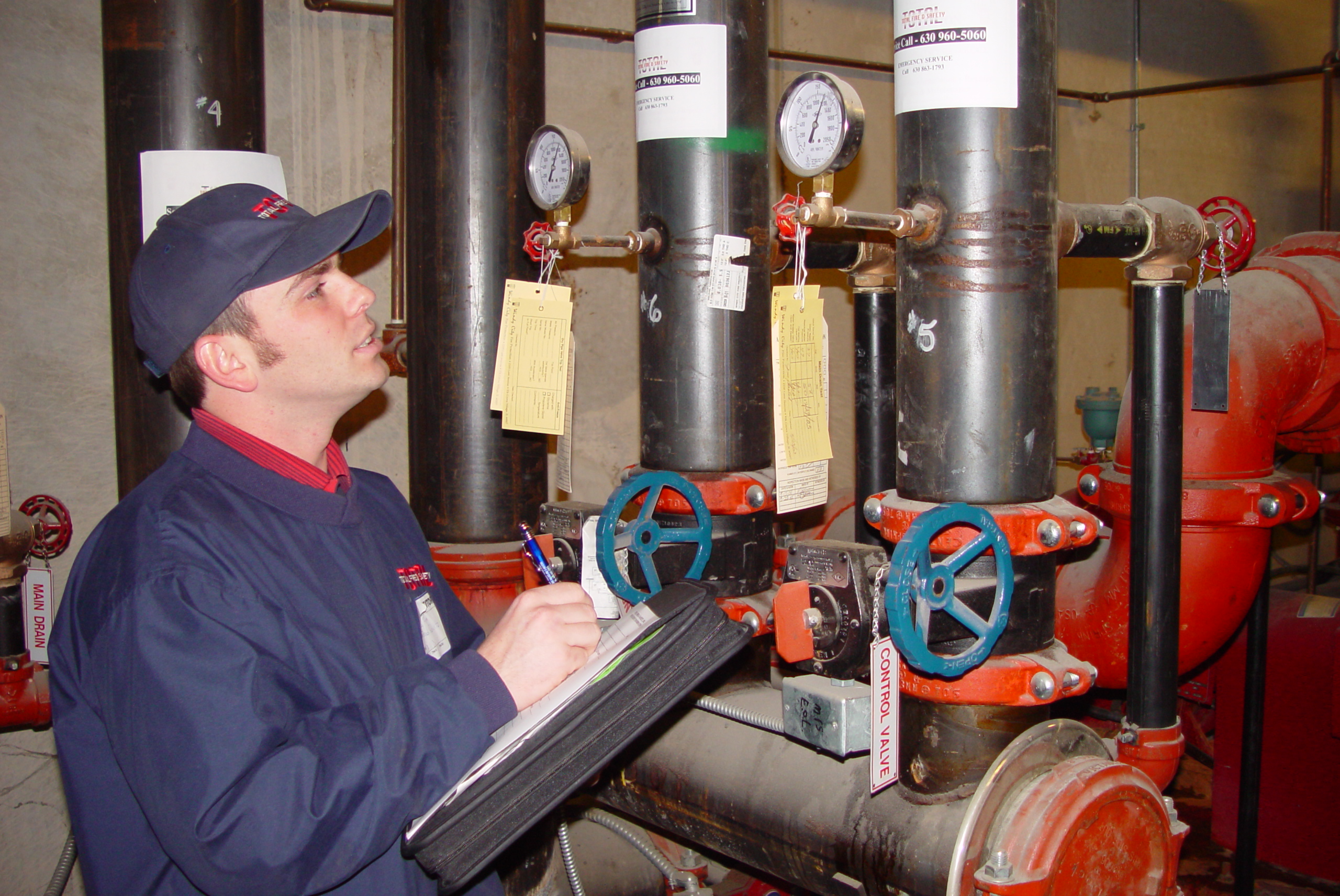
When people think of careers in fire safety in Illinois, they usually think of firefighters. But what about the folks who prevent the fires in the first place? These dedicated professionals work in the area of commercial fire safety. They help commercial buildings and residential dwellings stay up to code with the fire safety equipment, and thus, can save lives indirectly by keeping people safe and prepared for fire emergencies.
Providing fire safety to any business, at any level, starts with teamwork. If one aspect of fire safety fails (sprinkler, extinguisher, or alarm), it can make the difference between life and death. All the fire safety components work within a life safety ecosystem, which includes government code compliance, a skilled workforce, and an investment in safety equipment, installation, and training. As part of a commercial fire safety team such as Total Fire and Safety, you are part of a life-saving mission. We provide customers their first offense in putting out a fire on their premises.
According to the Bureau of Labor Statistics and their Occupational Outlook Handbook, the projected employment change for security and fire alarm system installers is expected to grow 14 percent, which is faster than the average career. They are expecting growth of 10,400 new jobs between 2016-2020. Currently, Illinois, the home state of Total Fire & Safety, is among the states in the nation that employs the most installers in this field. (see chart below).
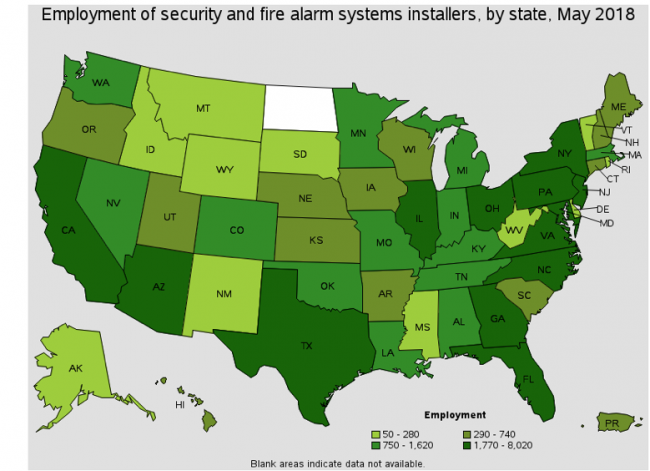 Chart reprinted from Bureau of Labor Statistics, Occupational Employment and Wages, May 2018, 49-2098 Security and Fire Alarm Systems Installers
Many of the careers in fire safety require a high school diploma or equivalent but mainly, on-the-job training. At Total Fire & Safety, we have a vigorous employee training program that prepares our people for many of the jobs that are so needed in the industry, such as customer service, sales representatives, dispatchers, fire alarm service technicians, fire extinguisher technicians, fire sprinkler service technicians, etc. We even have an on-site training facility (pictured below) where we regularly host classes and training modules for TFS employees.
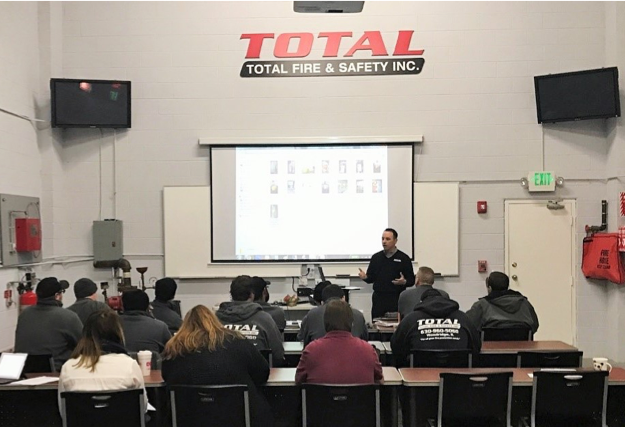
You’ve heard the phrase teamwork makes the dream work, right? At Total Fire and Safety we are always looking for dedicated professionals to join our commercial fire safety team, which has that has provided fire safety for over 30 years. If you are looking for employment or are ready for a career change, join Total Fire and Safety and see how working as a team can save lives.
To learn more about the opportunities available and experience needed at Total Fire and Safety, visit our employment page or search us on Indeed.
Category: Business Safety, Fire Safety, Total Fire and Safety Tags: commercial fire protection, commercial fire safety, employee training, fire and safety equipment, fire safety, fire safety training, Fireextinguishertraining, firesafetytraining, Total Fire and Safety, training | Comments Off on Find Your Career in Illinois Commercial Fire Safety
-
June 19, 2019 by Total Fire and Safety
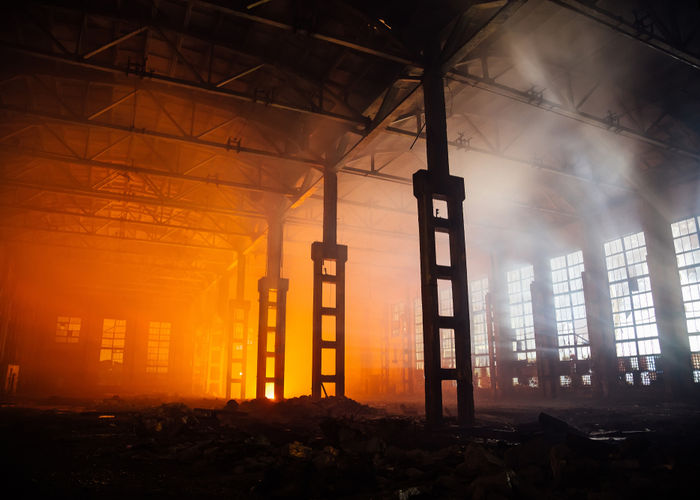
According to legend, the cause of the greatest fire in Chicago was a cow kicking over a lantern in a barn. In 1871, the entire city of Chicago was engulfed in flames. The fire lasted two days, left 300 people dead and over $200 million in damage. The event changed Chicago. Stricter fire codes were implemented, structures were built with different materials, and fire departments were equipped with better equipment and advanced training methods.
Today, fires in Chicago rarely go unexplained due to investigative divisions within the fire departments. The investigative teams are well trained in how to identify common causes of fires in Chicago. The most common causes of fires in Chicago vary by type.
Common Causes of Residential Fires
- Overusing extension cords
- Overusing Christmas lights/stringing them together under furniture
- Smoking materials (cigarettes, cigars, etc.…)
- Heating or electrical malfunction
- Cooking or kitchen fires
Common Causes of Industrial Fires
- Combustible dust
- Hot work
- Flammable gas or liquid
- Equipment and machinery fires
- Electrical hazard fires
How Fires are Investigated
Whether it is a residential fire or industrial fire, criminal or accidental, fires in Chicago and around the country all have a determining factor. The responsibility for finding the determining factor is up to the fire department. From a public standpoint, finding a cause seems impossible. How do they do it?
Upon arriving at the scene, firefighters note the color of the flames, the amount of smoke, the rate at which the fire spreads, and the sound it makes. These are all clues as to what is burning and how it is burning. It is incumbent of the firefighters to protect the evidence at the scene by:
- Limiting excessive fire suppression
- Preventing needless destruction to a property
- Using markers or cones to identify evidence
- Writing notes or making voice recordings of observations
- Covering areas that contain evidence
- Preserve delicate evidence like shoe or tire tracks
Once the fire is extinguished, the fire investigators dig through the ashes. They take photographs prior to and during the investigation for documentation. The objective of investigators is to locate the point of origin. This is achieved through the char patterns, direction of melt, and heat shadows. The burn patterns are often “V” shaped like an inverted cone. The fire burns upward, in a V-shaped pattern away from point of origin. The location is usually the most damaged by the fire. Although most of the determination of origin is science-based, there is a little bit of guessing and witness accounts. Fires in Chicago are likely to have one of four reasons:
- Electrical issues
- Natural acts
- Open flames
- Human action
Fires in Chicago have decreased over the years with an average of eight fire per day. Fortunately, fatal fires are rare, but even one is too many. It’s important for residents and businesses to practice fire safety. Is your business well equipped against fires? Total Fire and Safety can help safeguard your building and those occupying it with fire alarms, fire extinguishers, first aid kits, emergency lights and more. We’ll inspect your property to ensure it is up to code and even provide training classes for employees so they know how to use the equipment in an emergency. Give TFS a call today at 630-960-5060.
Category: Business Safety, Fire Extinguishers, Fire News, Fire Safety Tags: commercial fire protection, commercial fire safety, fire and safety solutions, Fire Extinguisher, fireextinguisher, firesafetytraining | Comments Off on In the Aftermath: Finding the Causes of Fires in Chicago
-
April 24, 2019 by Total Fire and Safety
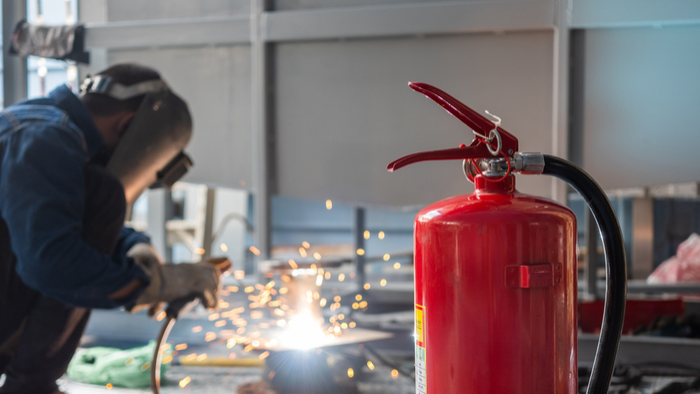
According to the National Fire Protection Agency (NFPA), between 2011 and 2015, there was an estimated 37,910 fires at industrial properties each year. These industrial fires resulted in 16 civilian deaths, 273 civilian injuries, and $1.2 billion in property damage.
Industrial fires are serious, but there are several things you can do at your plant or factory to minimize the possibility of an industrial fire. First, it’s important to know how they usually start.
The five most common causes of industrial fires are…
1. Combustible Dust Fires
A combustible dust is any dust or fine material that has the potential to catch fire and explode when it is mixed in the air. Many times, materials that are normally considered non-flammable can act as a combustible when fine particles are mixed with air in a particular concentration. Combustible dust happens in two waves. A primary explosion causes particles to become airborne, and then the dust cloud can ignite and cause a secondary explosion, much more severe than the first. Combustible dust can bring down entire facilities.
How do I Prevent Combustible Dust Fires?
- Implement a hazardous dust inspection, testing, housekeeping, and control program.
- Regularly inspect for dust residues in open and hidden areas.
- Use proper dust collection systems.
- If ignition sources are present, use cleaning methods that do not generate dust clouds.
- Control smoking, open flames, and sparks (mechanical and friction).
2. Hot Work Fires
Hot work is any activity that involves open flames or generates sparks or heat. This includes welding, heat treating, grinding, thawing pipes, torch cutting, brazing, soldering, etc. Hot work becomes a fire hazard when sparks and molten material travel…often as far as 35 feet, sometimes igniting combustible dust in other areas.
How do I Prevent Hot Work Fires?
- Train personnel on the hazards associated with hot work and make sure they are using proper safety equipment.
- Clear area of flammable materials including dust, gases, and liquids.
- Make sure a safety professional is on site to provide supervision of the work.
- Avoid hot work if possible.
3. Flammable Liquid and Gas Fires
These are most common in chemical plants. Flammable liquids and gases can ignite off sparks from the previous hazards or add fuel to an already burning fire.
How Do I Prevent A Flammable Gas Fire?
- Know the hazards of each flammable liquid and gas on-site. Read and follow the safety information for storage and follow the material safety data sheet included with the product.
- Properly store hazardous materials according to OSHA.
- Keep ignition sources away from flammable gases and liquids.
- Provide personal protective equipment, like gloves, bodysuits, vests, goggles, shoes etc.
4. Equipment and Machinery Fires
Equipment not properly installed, maintained, or operated correctly is a major cause of industrial fires. This is especially true for equipment associated with hot work and heating. Even machinery not seen as a fire hazard can become a risk with lack of proper maintenance.
How Do I Prevent Equipment and Machinery Fires?
- Training can help employers and employees identify possible risks and what to do if they find one.
- Keep the machines, equipment, and areas surrounding them, clean.
- Prevent machine overheating by following the manufacturer’s guidelines for recommended maintenance procedures.
5. Electrical Hazard Fires
Electrical fires are most common in manufacturing plants and include wiring that is exposed or not up to code, overloaded outlets, extension cords, overloaded circuits, static discharge, etc. A spark from electrical hazards can cause ignition of combustible dust and flammable liquids and gases.
How Do I Prevent Electrical Hazard Fires?
- Don’t overload electrical equipment or circuits.
- Unplug temporary equipment not in use.
- Avoid using extension cords.
- Use antistatic equipment as advised by OSHA and NFPA.
- Follow a regular cleaning schedule to ensure combustible dust and other hazardous materials are removed from areas that house equipment and machinery.
It can seem overwhelming to have to safeguard your facility against industrial fire hazards, but the pros at Total Fire and Safety can help you identify and prevent risks throughout your facility. They also provide fire safety training to educate employees on proper fire safety equipment operation and life safety procedures.
To take the first step in keeping industrial fires at bay at your facility, call Total Fire and Safety at 630-960-5060 or reach us at our 24/7 emergency line, 630-546-8909.
Category: Business Safety, Fire Safety, NFPA Compliance Tags: commercial fire protection, commercial fire safety, fire and safety solutions, fire safety training, Industrial Fire Prevention, Industrial Fire Safety, Total Fire & Safety | Comments Off on The Best Way to Prevent Industrial Fires
-
December 4, 2018 by Total Fire and Safety

A brand new year is a great time for businesses to evaluate what they can improve upon, even in terms of their commercial fire safety. No business is completely immune to accidental fires and having the right equipment in place year round can prevent potential devastation.
According to the National Fire Protection Association (NFPA), more than 3,300 fires break out in office buildings across the U.S each year. The NFPA reports that a number of people are killed or injured with an estimated $112 million in property damage.
If you’re a business set on achieving your 2019 goal of reaching NFPA compliance, take a look at checklist of equipment you need below for commercial fire safety. Anything missing? Call Total Fire & Safety. We can help!
____ Alarms
____ Extinguishers and Suppression Systems
- Conduct tests regularly to ensure function and pressure when activated.
- Schedule routine maintenance of equipment.
- Store extinguishers in open areas for easy access.
____ Emergency Lighting
- Effective emergency lighting throughout the building will help occupants to safety in an emergency.
- Schedule regular maintenance and inspections.
Equipment is essential and necessary to prevent major damage but people are too! Whether it’s putting out a fire or tending to the injured, what good is the equipment if you don’t have employees able to use it?
____ First Aid
____ Training Courses
- A comprehensive fire equipment training course on the use of fire equipment and first aid can place confidence in employees and keep everyone safe.
- Training employees reduces the chance of small fires starting and spreading.
You could have all the equipment ready and employees trained to use it but they need something else.
____ Emergency Preparedness Plan
- Remind employees to REACT-(remove from danger, ensure doors/windows are closed, activate alarm, call 911, treat as dangerous.)
- Conduct fire drills.
- Schedule inspections of all fire equipment.
- Have employees trained on firefighting equipment.
Making sure you have commercial fire safety in place can seem a daunting task but the pros at Total Fire and Safety are here to simplify it. TFS covers everything including inspection, maintenance, training, and keeping your building up to code so you are well protected in the event of an unforeseen fire. Give us a call today at 630-960-5060.
Category: Business Safety, Fire Alarm Monitoring, Fire Equipment Inspections, Fire exits, Fire Extinguishers Tags: commercial fire protection, commercial fire safety, commercial first aid kit, emergency exit lights, emergency lighting, fire and safety solutions, Fire Extinguisher, fire safety, fire safety training, fireextinguisher, firesafetytraining, firesprinklerinspections, first aid | Comments Off on The Business Owner’s Checklist for Commercial Fire Safety in 2019
-
March 15, 2018 by Total Fire and Safety
 Nobody thinks much about emergency exit lights. But if the power suddenly goes out, smoke fills the room and you can’t see a foot in front of you, relying on the emergency lights may be your only means of escape. Nobody thinks much about emergency exit lights. But if the power suddenly goes out, smoke fills the room and you can’t see a foot in front of you, relying on the emergency lights may be your only means of escape.
Emergency exit lights are essential to safety in any dangerous situation. They can alarm someone in a fire, be the only source of light in the dark, and the key to safely exiting the building. Emergency exit lights are often overlooked and taken for granted, but take note of how many you come across every day. Do you realize how many requirements and regulations go into the installation and maintenance of one exit sign?
There are numerous agencies that govern emergency exit lighting and signs: OSHA (Occupational Safety and Health Administration), NFPA (National Fire Protection Administration, JCAHO (Joint Commission on Accreditation of Healthcare Organizations and the International Building Code and International Fire Code. Above all these agencies, the local authority is responsible for monitoring and enforcing building/fire codes.
According to OSHA, an exit route is defined as a continuous and unobstructed path of exit travel from any point within a workplace to a place of safety. There are three parts to an exit route:
- Exit access-part of the exit route that leads to an exit.
- Exit-part of the exit route that is separated from other areas and provides a safe means of travel to exit discharge.
- Exit discharge-part of the exit route that leads to directly outside or refuge area.
OSHA’s requirements for the lighting of these afore mentioned exit routes is covered under 1910.37(b). It states that each exit route must be sufficiently lighted so an employee with normal vision can see along the exit route and each exit must be clearly visible and marked by a sign reading “EXIT.” Additional information for OSHA requirements can be found at www.osha.gov.
The NFPA guidance for emergency exit lighting and signs can be found in the NFPA 101, Life Safety Code. The NFPA’s Life Safety Code provides information for placement, illumination, and visibility for exit signs.
- Placement of exit sign. Any exit signs must be located so that no point in an exit access area is more than the sign’s viewing distance, or 100 feet from the nearest sign.
- Visibility of exit signs-Every sign must be located and of such size, distinctive color and design that is visible and contrasts from the background of its placement. NFPA also states no decorations, furnishings, or equipment that impairs visibility of a sign shall be permitted. Nothing should be placed near an exit sign that distracts attention and inhibits visibility of an exit sign.
- Illumination of Exit Signs-The NFPA states all exit signs must be illuminated by a reliable light source and legible in normal and emergency exit lighting modes. There are two categories of illumination: external illumination, which comes from outside the exit sign and internal illumination, which comes from a source inside an exit sign.
According to the NFPA, emergency illumination must be provided for a minimum of 1.5 hours in the event of power outage. The emergency lighting must be illuminated not less than an average of one lumen per square foot. The maximum illumination at any point can be 40 times the minimum illumination. All emergency exit lighting must be able to provide lighting automatically when normal light is interrupted.
Many emergency exit lights are now using LED lights. The NFPA states that LED lights are longer lasting, provide better light and are most durable. In emergency situations, LED lights emit sufficient lighting and are most effective when placed properly. They are also most energy efficient, saving the building money.
According to the NFPA requirements for testing, there are three categories of emergency lights: traditional, self-testing, and computer base self-testing. A monthly activation test which involves having the lights illuminate for no less than 30 seconds and an annual test which keeps the lights illuminated for 1.5 hours, simulating a long-term emergency. Records of these test must be maintained for inspection.
Many regulations, codes, and considerations go into the signs and lights you see every day so it is important to have regular maintenance and testing of these lights. Total Fire and Safety has a knowledge team for inspecting emergency exit lighting. With regular maintenance and testing from Total Fire and Safety, you can be assured your emergency exit lighting is up to code and the safety of your employees/tenants is assured. Give us a call today 630-960-5060.
Category: Business Safety, Fire code violation, Fire Equipment Inspections, Fire exits, Fire News, Fire Safety, Health and Safety, LED Lighting, NFPA Compliance, Total Experience, Total Fire and Safety Tags: commercial fire protection, commercial fire safety, emergency exit lights, emergency lighting, fire and safety equipment, fire and safety needs, fire and safety solutions, fire safety in the news, fire safety solution, fire safety training, lifesafety, safety | Comments Off on Are You In the Dark About Emergency Exit Lights?
-
February 13, 2018 by Total Fire and Safety

When a ballistic missile warning sounded in Hawaii recently, few people had an emergency preparedness plan in place. Instead, people were sent into panic. Parents threw their children into sewers, people caught in traffic ran from their cars, some Googled “how to shelter from a nuclear bomb.” We can look at this now in hindsight and think we would have handled it differently. But would we? Whether it’s a ballistic missile, tornado, or a fire it is important to have an emergency preparedness plan.
When a fire occurs in the office, people are likely to react the same way. However, if employees understand what’s going on, what to do, where to go and how to get there, panic will not set in. A fire emergency preparedness plan will help employees feel in control during an emergency and do what needs to be done. .
One way to help employees respond appropriately in an emergency is to remember to REACT:
- R-Remove persons from danger. Know the location of fire exits and that they are not blocked. Steer clear of elevators and equip them with warning signs: in case of fire do not use. They can trap people and must be available to firefighters. Figure out a designated meeting area for employees, safe from danger. Make a procedure in case of entrapment in the building. Assign someone to always keep a list of employees and visitors, so you can begin a roll call once in the safety area.
- E-Ensure doors and windows are closed. Keep doors and windows closed to prevent spreading of the fire.
- A-Activate building alarm. Make sure alarms or a warning signal are working properly and that your employees are familiar with the sound. Most importantly, have regular fire drills.
- C-Call the fire department. Never investigate the fire on your own. Time is minimal for your employees to reach safety quickly.
- T-Treat all fires as dangerous.
A fire preparedness plan also includes having the right equipment and in working order too. Does your place of business have everything it needs to survive a fire? And has it been inspected lately? Know that your facility is up-to-date on the systems it needs to have ready to go in case of a fire:
Don’t forget that the second part of having the right fire equipment is having employees that can operate the equipment safely. Total Fire and Safety offers training courses for employees on all our technologies and equipment. Having employees properly trained improves chances of putting out small fires.
As you can see there are many safety precautions to include in a fire preparedness plan. If your building does not have the proper safety equipment or it is not up to date, there could be catastrophic consequences. Total Fire and Safety always has the well-being of the customer in mind as we complete our inspections. We never give less than 100 precent because you can never be too prepared for a fire. Contact us at: 630.960.5060
Category: Business Safety, Fire code violation, Fire Equipment Inspections, Fire exits, Fire Extinguishers, Fire Extinguishers, Fire Safety, Sprinkler Systems Tags: commercial fire protection, commercial fire safety, commercialfiresprinkler, emergency exit lights, emergency plan, emergency preparedness, employee training, Extinguishertraining, fire safety in the news | Comments Off on Fire in the Office! Do You Have a Fire Emergency Preparedness Plan?
-
November 29, 2017 by Total Fire and Safety
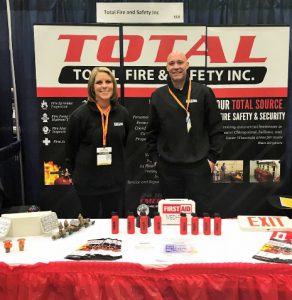 Robin Jones, business development (left) and Jason LeGrand (outside sales) at the latest Co-op and Condo Expo at Navy Pier in Chicago. Did you stop by and see us at the latest Co-op and Condo Expo at Navy Pier in Chicago?
Our team was on hand to talk to condo owners, homeowner association board members, property managers and apartment building owners about their fire safety. We participate every year, not only to meet new prospective clients, but to see our many satisfied ones that come for the educational seminars and exhibit floors.
Visitors to our booth walk away with one of our fire extinguisher-shaped stress balls (if you don’t have one, ask your Total Fire & Safety technician!) and a better understanding of their fire safety responsibilities as property owners or managers. What were the most frequently asked questions?
- How do I know if I am in compliance? (We can help perform inspections to make sure buildings are up-to-date with NFPA requirements, which vary depending on your structure and occupancy.)
- What is this wireless fire alarm technology and will it save me money? (Besides making sure your fire alarms are inspected, in compliance and operational, we can update your old equipment to reduce maintenance costs and improve performance.)
- What do my tenants need to know about fire safety? (We offer solutions and fire safety training on a customized basis.)
- Do you offer first aid kits? (We offer a variety of commercial first aid kits based on your environment’s needs. A first aid kit can make a big difference in the comfort and safety of your tenants or employees!)
- Why Total Fire & Safety? (We are one of the most experienced commercial fire protection companies on the market and make use of some of the most technologically advanced reporting features available.)
We hope to see you at the show next year! Until then, if we can be of assistance with your fire safety needs, don’t hesitate to contact us at 630.960.5060.
Category: Business Safety, Client Events, Fire Safety, NFPA Compliance, Total Fire and Safety, Uncategorized Tags: client events, commercial fire protection, commercial fire safety, Events, fire and safety needs, Total Fire & Safety, wireless fire alarms | Comments Off on TFS at the Co-op and Condo Expo
|

|
|
|
|
|
|

 Facebook
Facebook
 Instagram
Instagram
 LinkedIn
LinkedIn








 Nobody thinks much about
Nobody thinks much about 

